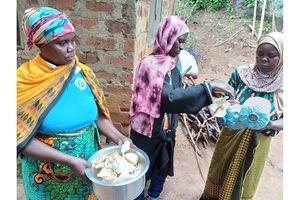Big guns keep losing as mobile phone subscriber base shrinks

Mr Ian Ferrao
What you need to know:
Airtel, which held a 28 per cent market share in December, slid to 27 per cent thereby giving way for Tigo to settle comfortably in the second position with a 29 per cent slice on its back.
Dar es Salaam. Vodacom and Airtel Tanzania were on the losing end during the first half of this year as the telecommunication market registered a negative growth rate amid a growing rivalry.
The market – which registered a total of 1,448,782 new Subscriber Identification Module (Sim) cards during the last quarter of last year – lost some 232,993 Sim cards during the first quarter of this year, sending red signals even to some new entrants.
The number of Sim cards dropped by 0.5 per cent to reach 39.6 million between January and March 2016 from 39.8 million that was registered between October and December 2015, according to latest figures from the Tanzania Communications Regulatory Authority (TCRA).
Vodacom, which remains the market leader, lost 340,144 Sim cards during the first half of this year. Airtel was another casualty of the growing market rivalry after it lost some 332,067 Sim cards during the three months to March 2016.
With the new figures, Vodacom’s subscriber market share dropped to 31 per cent as of March 2016 from 32 per cent during the preceding quarter.
Similarly, Airtel, which held a 28 per cent market share in December, slid to 27 per cent thereby giving way for Tigo to settle comfortably in the second position with a 29 per cent slice on its back.
Tigo garnered 255,440 new sim cards to bring the total number of its subscribers to 11.37 million in March.
Some analysts are of the view that the drop in Sim cards for Vodacom and Airtel could have been precipitated by a change in strategy that has seen them shifting from voice to data in terms of revenue generating streams.
Apparently, this view could be supported by what the Vodacom Tanzania managing director, Mr Ian Ferrao, said in Dar es Salaam in April.
Speaking at the launch of a report on the mobile phone’s contribution to Tanzania’s economy for three financial years from 2012/2013 to 2014/2015, Mr Ferrao said in April that his company’s focus is now on increasing the number of data subscribers to increase its revenues and its entire contribution to the country’s economy.
“Increasing the number of data subscribers is a key focus area for Vodacom with the expectation that data users and revenue will increase over the next few years,” he said.
The data he produced at that event showed that with the growing number of smart devices, Vodacom has grown its active data customer base by 45 per cent from December 2013 to December 2014 and as of 2015 had over 5.1 million active data customers. During the three years, the company has invested about Sh664 billion into modernising its network in a way that increases the quality of services and reducing communication cost.
But Mr Ferrao could not comment on the newly released TCRA figures as calls and short message services to him went unanswered.
In the same vein, Airtel’s corporate affairs director, Ms Beatrice Singano could not be reached for comments despite promising that she would call back when The Citizen contacted her on Thursday last week. Similarly, The Citizen’s enquiries to Tigo’s brand manager, Mr William Mpinga, proved futile for unknown reasons.
But a few months ago, the Tigo general manager, Mr Diego Gutierrez, said the company’s growth during the past few years has been fuelled by a number of innovative factors.
“The company’s success story is anchored in good service, affordability, nationwide coverage, use of latest technology, innovation and being close to customers,” Mr Gutierrez told The Citizen in April this year.
Some of the innovative products that were driving the growth, according to Mr Gutierrez, include a number of applications such as interoperability, banking integration, international money transfer and the Tigo Pesa quarterly profit share scheme.
“We also have the digital inclusion initiatives which include free access to the social media initiative, our Facebook in Kiswahili product, Smartphone with menu in Kiswahili and the free WhatsApp which we launched two months ago,” he said. The company, according to Mr Gutierrez, is investing a total of $120 million this year in a number of areas that seek to increase area coverage and improve its services. The company’s Fourth Generation/Long Term Evolution (4G/LTE) technology has so far been rolled out to a total of six regions in the country as plans are on the cards to make sure that it reaches capitals for all of Tanzania’s regions by the end of this year.
Smart, which is one of the new entrants, was also a casualty in the competition process as it shed 407,434 Sim cards during the first quarter of 2016 to shelve a single percentage point of its market share. It thus commanded a three per cent share in March 2016 from four per cent during the preceding week.
Halotel, which launched its services in the country in October last year, emerged as the most attractive telecommunication firm during the first quarter of 2016 as it garnered 571,669 Sim cards to send red lights to the fourth-placed Zantel.
With the new Sim cards, Halotel had a total of 1,798,348 subscribers which saw it commanding a four per cent market share to its name, slightly behind Zantel’s 1,858,902.
TTCL won 34 new subscribers during the period under review.
Additional Reporting by Alex Malanga


